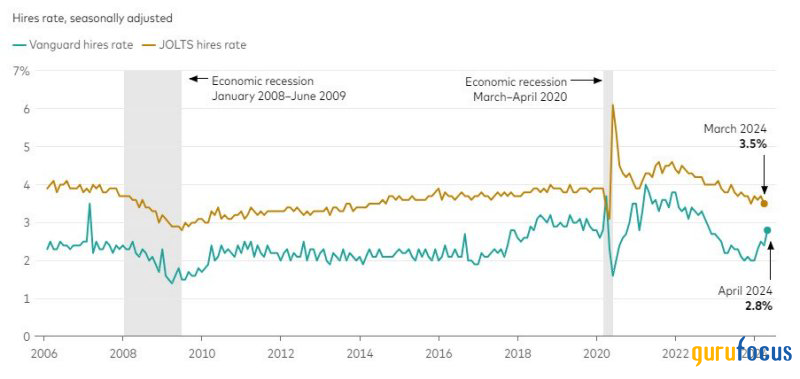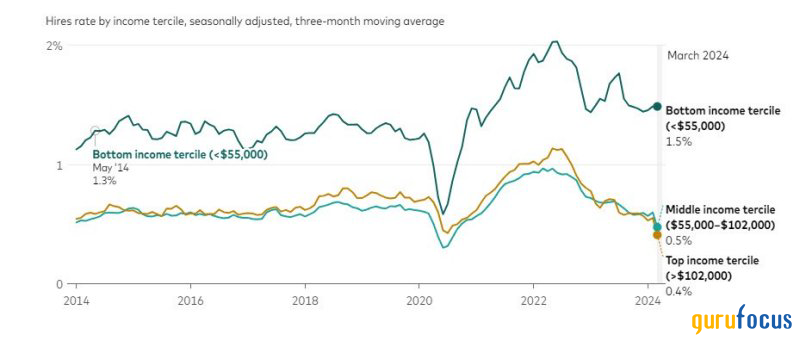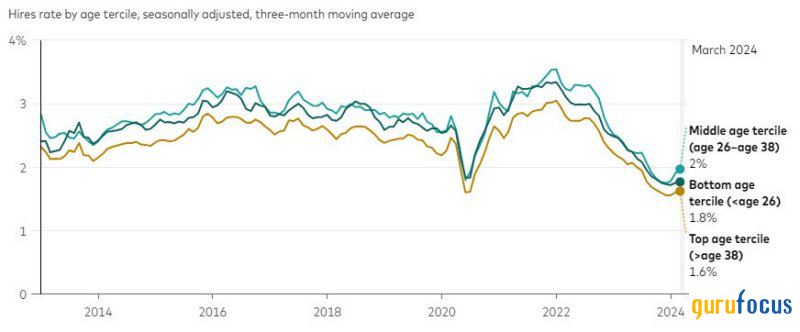Vanguard Retirement Perspectives- Labor Market Pulse: Young, Lower-Income Workers Gaining Ground
Proprietary Vanguard data suggest that the overall U.S. hires rate is trending higher. Even as demand for middle- and top-income earners continues to soften, hiring activity for workers earning less than $55,000 remains elevated compared with 2019 levels, leading to better employment opportunities and solid inflation-adjusted wage growth for that group. The overall trend should boost consumer spending and support GDP growth in the second half of 2024.
The hires rate has been climbing recently
Vanguard's proprietary data on enrollments in 401(k) retirement plans point to an uptick in the pace of hiring. The hires ratewhich refers to new hires as a share of existing employeesreached 2.8% in April 2024, up from 2.4% in March 2024 and at its highest level since October 2022.
However, the Job Openings and Labor Turnover Survey (JOLTS), published by the U.S. Bureau of Labor Statistics, has shown a downward trend in the hires rate, with the latest reading at 3.5% in March.
Both JOLTS and Vanguard data showed a general slowdown in hiring throughout 2023.
Vanguard data indicate hiring has risen over the first four months of 2024

Notes: The Vanguard hires rate is calculated at the firm level and is based on new enrollments in 401(k) retirement plans administered by Vanguard divided by the number of all active 401(k) plan participants in a given month. New hires are recorded based on their hire date rather than their retirement plan enrollment date. The last 12 months of the Vanguard hires rate series are adjusted upward to account for an empirically observed lag in 401(k) enrollment times for new hires. The series is seasonally adjusted using the X-13ARIMA-SEATS method. The dataset represents a rolling two-year sample of firms of all sizes across all sectors of the economy that offer retirement plans, which Vanguard has administered since January 2003. Job Openings and Labor Turnover Survey (JOLTS) data are based on a nationally representative survey of 21,000 nonfarm business and government establishments. The two vertical bars indicate economic recessions, as identified by the National Bureau of Economic Research.
Source: Vanguard, as of April 2024.
Hiring trends have diverged for low- and higher-income workers
The hires rate for the bottom third of earnersthose with annual pay below $55,000has generally surpassed that of higher earners. Although JOLTS does not provide data by income level, data from that survey also indicate greater labor market activity in lower-wage sectors such as leisure and hospitality and retail trade. (It is worth noting that Vanguard retirement plan participants typically have higher incomes than the broader U.S. population.)
While demand for low-paid workers remains elevated relative to pre-COVID-19 levels, hiring activity in higher-paying occupations contines to moderate, explained Adam Schickling, a senior Vanguard economist. This is partly a reflection of lower-paying service industries still trying to recover from the COVID shocka challenge since many of those workers have transitioned to higher-paying opportunities. Nonetheless, it's clear that higher-paying industries are taking a considerably more cautious approach to hiring relative to the hectic 2021 to 2022 hiring surge.
The pace of hiring has remained robust for low-income workers in 2024

Notes: The hires rate by income percentile refers to new hires as a share of existing employees. The Vanguard hires rate is calculated at the firm level and is based on new enrollments in 401(k) retirement plans administered by Vanguard divided by the number of all active 401(k) plan participants in a given month. The hires rate series is seasonally adjusted using the X-13ARIMA-SEATS method and transformed into a three-month moving average. Income is inferred from data on participants' 401(k) savings-rate elections and realized contributions. Data is reported on a lag because of data coverage limitations.
Source: Vanguard, as of March 2024.
Hiring dynamics among young workers
"Using our proprietary data, we can now look at hiring trends by age cohort," Vanguard investment analyst David Pakula said. Except during the COVID-19 pandemic, hiring rates across all three age groups have tended to closely track one another over time. In recent months, though, there has been a modest uptick in hiring among younger workers, while hiring rates have been flatter for older workers.
These relative similarities in hiring trends by age stand in contrast to the noted divergence in the hiring patterns between low-paid and higher-paid workers. Income, rather than age, seems to be the differentiating factor in hiring trends right now, said Fiona Greig, Vanguard's global head of investor research and policy. Workers of all ages are seeing a rise in hiring, but it's really just lower-income workers who are driving the increase. The job market has softened for the top two-thirds of earners.
Hirings showed similar gains in 2024 across age groups

Notes: The hires rate by age percentile refers to new hires as a share of existing employees. The Vanguard hires rate is calculated at the firm level and is based on new enrollments in 401(k) retirement plans administered by Vanguard divided by the number of all active 401(k) plan participants in a given month. The hires rate series is seasonally adjusted using the X-13ARIMA-SEATS method and transformed into a three-month moving average. Data is reported on a lag because of data coverage limitations.
Source: Vanguard, as of March 2024.
About Vanguard hires data
Total hires and the hires by income and age have several methodological differences due to data limitations when pairing firm hire rates with worker attributes. The total hires chart ends in April 2024 and contains a rolling sample of 1,269 firms for which Vanguard provided 401(k) plan recordkeeping services for the prior 24 months. We also use the X-13-ARIMA-SEATS adjustment to remove seasonal patterns in the data. The income- and age-based charts plot data through March 2024 and are based on a monthly cross section of 401(k) clients because of data availability constraints. The income cut reflects a monthly sample of 1,745 firms, and the age cut contains a sample of 1,980 firms. For those two charts, we calculated a three-month moving average in addition to the X-13-ARIMA-SEATS adjustment to smooth the data given sample-size limitations. These methodological differences may lead to differences in trends between the aggregate hire chart and the income- and age-based charts.
Vanguard hires data do not capture the whole U.S. economy, since roughly only half of workersa group disproportionately composed of higher-income workershave access to employer-sponsored retirement plans. Moreover, employers that offer 401(k) plans tend to be larger, more mature, and concentrated in certain industries.
This article first appeared on GuruFocus.

 Yahoo Finance
Yahoo Finance 